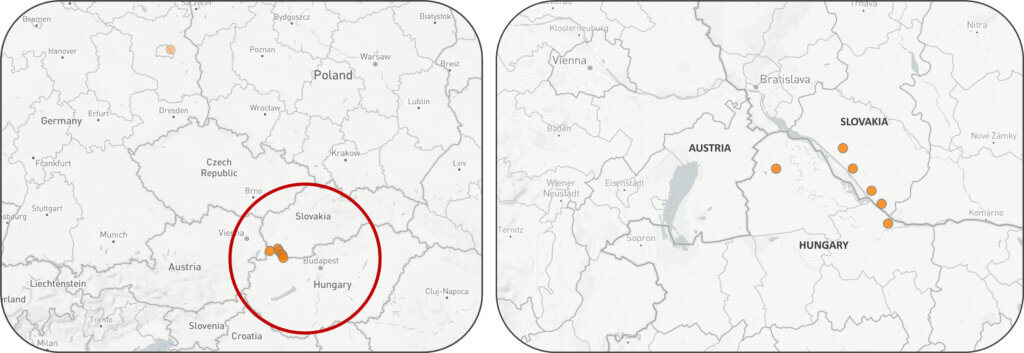
As part of its mission to identify emerging disease threats to the US pork industry, SHIC is monitoring the recent FMDV incursions in the EU, with Slovakia being the most recent country to report detection. Slovakia confirmed its first FMD outbreak in over 52 years at four cattle farms in the southern regions of Dunajská Streda and Komárno, near the Hungarian border. On March 30, 2025, a fifth cattle farm in the western Bratislava region was confirmed with FMD. Over 6,000 cattle are affected, with animals showing classic FMD symptoms such as fever, excessive salivation, and mouth and hoof blisters. Within the framework of the SHIC Global Swine Disease Monitoring Report, the team at the Center for Animal Health and Food Safety (CAHFS) has prepared this update of the FMDV situation in Slovakia.
The Slovakian outbreak follows recent cases in Hungary and Germany, making it the third confirmed FMD outbreak in Europe in 2025. Emergency measures, including movement bans, culling, and zoo closures, have been implemented while investigations continue to determine the source and contain further spread.
Timeline of Events: Key Dates in Slovakia’s FMD Outbreak
● March 21, 2025: The first three FMD outbreaks were confirmed at three cattle farms in Medveďov, Ňárad, and Baka (Dunajská Streda District), involving a total of over 2,760 susceptible animals (Baka: 1,301; Ňárad: 790; Medveďov: 670). A state of emergency was declared in the district.
● March 22–23, 2025: Vaccination completed at affected farms in Medveďov and Ňárad to reduce virus shedding before culling. Culling operations begin at the Baka farm, progressing at 300 animals per day.
● March 24, 2025: Ongoing culling operations and transport of slaughtered animals to disposal facilities.
● March 25, 2025: The fourth FMD outbreak was confirmed at a farm housing 270 cattle near Malá Lúč (Lúča na Ostrove), approximately 10km from Baka.
● March 30, 2025: The fifth FMD outbreak was confirmed at a large cattle farm housing 3,750 cattle in the western village of Plavecký Štvrtok, about 30 km northwest of Bratislava and not far from the Austrian and Czech borders. Authorities confirmed that this farm has a connection with one of the outbreaks in Hungary (Lével). Vaccination has started.
Outbreak Locations
The outbreaks confirmed in the southern part of the country are near the border with Hungary. These areas, particularly the Dunaszerdahely region, are major hubs for Slovakian livestock production, housing approximately 13,000 cattle and 128,000 pigs, and are now under intensive control measures due to their heightened vulnerability to disease spread.
1. Medveďov (Dunajská Streda District, Trnava Region)
● One of the first outbreak sites.
● Home to a large herd of milking cows.
● Managed by Naše Farmy, part of the J&T investment group.
2. Ňárad (Dunajská Streda District, Trnava Region)
● Also part of the Naše Farmy network.
● Symptoms were first noticed in mid-March.
3. Baka (Dunajská Streda District, Trnava Region)
● Operated by EXATA Group, owned by major Slovak business figures.
● The farm housed over 1,300 dairy cows and calves.
● A major milk producer, supplying 12 million liters annually prior to the outbreak.
4. Lúča na Ostrove (Dunajská Streda District, Trnava Region)
● Fourth confirmed outbreak, announced on March 25, 2025.
● Infected herd includes approximately 270 cattle.
● Located near previously affected areas, contributing to growing concerns about regional spread.
5. Plavecký Štvrtok (Malacky district, Bratislava Region)
● Fifth confirmed outbreak, announced on March 30, 2025.
● Affected site housing around 3,000 cows, 150 heifers, and 600 calves.
● Located approximately 30 km from Bratislava near the Czech and Austrian borders.
Cause and Transmission: How and Why the Outbreak Occurred
The exact source of the outbreak remains under investigation. However, authorities suspect the virus likely entered from neighboring Hungary, where an outbreak was reported in early March 2025, near the Slovak border. Affected farms are located in regions with dense livestock populations, making the area particularly vulnerable to fast and extensive transmission. The proximity of outbreak sites to Hungary and the interconnected nature of livestock trade and transport further contributed to the virus’s spread.
Measures Taken
In response, Slovakia has implemented strict emergency measures to contain the outbreak and prevent further spread:
● State of Emergency declared in the Dunajská Streda district.
● Nationwide ban on the movement of cloven-hoofed animals (cattle, pigs, sheep, goats, and farmed game), except for necessary transport within the same holding.
● International transport restrictions for susceptible animals through Komárno and Dunajská Streda districts.
● Culling of over 3,000 cattle, with operations ongoing and averaging 300 animals per day.
● 10,000 vaccine doses procured by the Ministry of Defence to support the emergency response and enhance outbreak control capacity.
● Vaccination at selected outbreak sites (e.g., Medveďov, Ňárad) to reduce virus shedding prior to humane culling.
● Disposal protocols in place:
○ Carcasses of visibly infected animals are incinerated at rendering plants.
○ Uninfected carcasses are buried at designated sites.
○ All transport containers are disinfected and sealed, with inspections at departure and arrival points.
● Over 1,500 police officers deployed to enforce movement restrictions and control zones.
● Fire and rescue services engaged in animal carcass transport, disinfection, and culling support.
● Installation of disinfectant fords and vehicle checkpoints on roads near infected premises.
● Closure of all zoos, circuses, and animal display facilities across Slovakia.
● Public forest access is banned in affected districts to reduce the risk of wildlife-mediated spread.
● Authorization for hunters to cull wild susceptible animals showing signs of disease, even outside regular hunting seasons.
● Coordination with the EU and WOAH, and an official request for financial compensation submitted to the European Commission.
EU experts acknowledged Slovakia’s response as best practice, strengthening the country’s eligibility for support.
Overview of International Responses to Slovakia’s FMD Outbreak
Poland
● Comprehensive import ban on live cloven-hoofed animals, meat, dairy, and by-products from Slovakia and Hungary.
● Enhanced inspections and disinfection at border crossings with Slovakia.
● Installation of disinfection gates at key border points (e.g., Barwinek).
● Trace-back investigation of over 400 animal shipments from Slovakia in the past month.
Czech Republic
● Initial ban on the transport of susceptible animals from Hungary and Slovakia (except for direct transport to slaughterhouses) imposed on March 7, lifted on March 18, then reinstated on March 21 following FMD confirmation in Slovakia.
● Import ban on livestock and animal products from affected areas of Slovakia (reinstated March 21).
● Border inspections at four major crossings, conducted by veterinary inspectors, police, and customs officers.
● Mandatory disinfection of transport vehicles and required documentation for biosecurity compliance (e.g., proof of vehicle disinfection, animal health certificates).
● Access restrictions to farms for individuals who had recently traveled to outbreak areas (e.g., Hungary, Slovakia).
● Deployment of 16 Czech firefighters and a mobile livestock culling unit to Slovakia to assist with containment, disinfection, and humane slaughter operations.
● Appeals to Czech farmers and agricultural unions to enforce strict biosecurity, including hygiene, disinfection, and bans on unauthorized entry into livestock facilities.
United Kingdom
● Banned imports of cattle, pigs, meat, dairy, and animal by-products from Slovakia and Hungary.
● Since 8 March, travellers to Great Britain are prohibited from bringing meat, meat products, milk, dairy products, certain composite products, animal by-products of pigs and ruminants, as well as hay and straw from Hungary and Slovakia.
Canada
● Immediate import restrictions on live animals, raw meat, milk, and animal products from Slovakia and Hungary.
● Border alert issued, and import certificates reviewed for compliance.
● Shipments arriving after February 2, 2025, are being traced and assessed.
Ukraine
● Ban on imports of live animals, genetic materials, and animal products from Slovakia and Hungary.
● Ongoing surveillance of the domestic epizootic situation to maintain disease-free status.
Australia
● Suspended imports of meat and dairy products from both Slovakia and Hungary due to FMD detection.
Ongoing Concerns and Next Steps
Slovakia’s FMD outbreak has raised serious concerns for both animal health and economic stability. With over 3,000 cattle affected and outbreaks confirmed near Hungary’s border, there is a high risk of regional spread, especially in areas with dense livestock populations. Authorities are closely monitoring wildlife and nearby farms to prevent further transmission. Despite containment efforts, the economic impact is growing, with estimated losses exceeding €10 million. Farmers are concerned about long-term consequences, including trade disruptions and livestock restocking challenges. Slovakia is coordinating with the European Commission to secure financial compensation and technical support. The government is also working with the WOAH to maintain transparency and ensure proper control measures.
Next steps include:
● Completing culling and disinfection operations.
● Expanding surveillance and testing in at-risk zones.
● Continuing cross-border coordination with neighboring countries.
● Finalizing damage assessments to access EU compensation mechanisms.
The situation remains dynamic, with authorities stressing the need for continued vigilance and swift regional cooperation to prevent further outbreaks. The distribution of FMD outbreaks is presented on Figure 1.

References
Emergency Measures for Foot-and-mouth Disease Enter into force
FMD confirmed in Slovakia, following outbreak in neighbouring Hungary
Slovakia reports first foot-and-mouth cases in 50 years
News digest: Slovakia confirms foot-and-mouth disease, begins culling livestock
Culling of Cattle at Baka Farm Continues at Rate of 300 Animals per Day
Foot-and-Mouth Disease Outbreak Prompts State Of Emergency In Slovakia
Cattle Vaccination in Medvedov and Narad Farms Completed, Culling Not Yet Begun
Slovakia to Request Compensation from EC for Foot-and-Mouth Disease
FMD: Slovakia and Hungary both see further outbreaks this week
Czech Republic Helping Slovakia Tackle Foot-and-mouth Disease
Czech firefighters join Slovakia’s fight against foot-and-mouth outbreak
Animals from Slovakia and Hungary Can Be Transported Again to Czech Republic
Czechia Bans Animal Transport from Hungary, Imposes Border Control with Slovakia
Czech Republic bans livestock imports from Slovakia after new foot-and-mouth outbreak
Czech Republic reinstates border controls with Slovakia following foot-and-mouth disease outbreak
Fifth outbreak in Slovakia
Copyright 2025 | Swinehealth.org | Website by Heartland Marketing Group